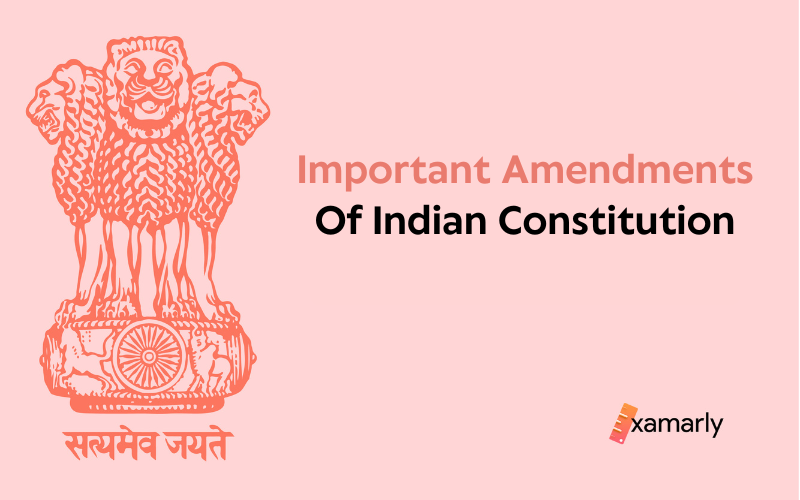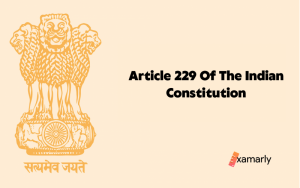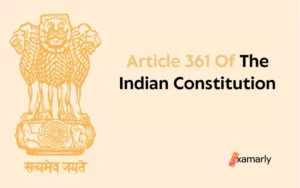In the General Studies segments, Indian Politics is a crucial subject. There are questions about Indian Constitutional Amendments in the GS section of every competitive examination.
In order to meet emerging demands, the Indian Constitution has to be amended. Article 368 of the Indian Constitution grants the Parliament the authority to modify the Constitution. The Parliament may alter its methods, but it is not permitted to change the provisions that form the basic structure of the Constitution.
The total number of amendments in the Indian constitution is 105. Some of the more significant ones will be covered in this article.
- List of Most Important Amendments of the Indian Constitution for UPSC
- 1st Constitutional Amendment Act, 1951
- 2nd Constitutional Amendment Act, 1952
- 4th Constitutional Amendment Act, 1955
- 7th Constitutional Amendment Act, 1956
- 8th Constitutional Amendment Act, 1960
- 9th Constitutional Amendment Act, 1960
- 10th Constitutional Amendment Act, 1961
- 11th Constitutional Amendment Act, 1961
- 12th Constitutional Amendment Act, 1962
- 13th Constitutional Amendment Act, 1962
- 14th Constitutional Amendment Act, 1962
- 17th Constitutional Amendment Act, 1964
- 18th Constitutional Amendment Act, 1966
- 19th Constitutional Amendment Act, 1966
- 21st Constitutional Amendment Act, 1967
- 24th Constitutional Amendment Act, 1971
- 25th Constitutional Amendment Act, 1971
- 26th Constitutional Amendment Act, 1971
- 31st Constitutional Amendment Act, 1972
- 35th Constitutional Amendment Act, 1974
- 36th Constitutional Amendment Act, 1975
- 38th Constitutional Amendment Act, 1975
- 40th Constitutional Amendment Act, 1976
- 42nd Constitutional Amendment Act, 1976
- 44th Constitutional Amendment Act, 1978
- 52nd Constitutional Amendment Act, 1985
- 61st Constitutional Amendment Act, 1989
- 65th Constitutional Amendment Act, 1990
- 69th Constitutional Amendment Act, 1991
- 71st Constitutional Amendment Act, 1992
- 73rd Constitutional Amendment Act, 1992
- 74th Constitutional Amendment Act, 1992
- 86th Constitutional Amendment Act, 2002
- 88th Constitutional Amendment Act, 2003
- 92nd Constitutional Amendment Act, 2003
- 95th Constitutional Amendment Act, 2009
- 97th Constitutional Amendment Act, 2011
- 100th Constitutional Amendment Act, 2015
- 101st Constitutional Amendment Act, 2016
- 102nd Constitutional Amendment Act, 2018
- 103rd Constitutional Amendment Act, 2019
- 104th Constitutional Amendment Act, 2020
- UPSC Questions Related to the Amendment of the Indian Constitution
- Conclusion
- FAQs
List of Most Important Amendments of the Indian Constitution for UPSC
Major amendments that amended the Indian Constitution were enlisted below:
1st Constitutional Amendment Act, 1951
- The state has the authority to develop special provisions to advance socially and economically underprivileged groups.
- A ninth schedule was added to shield laws pertaining to land reform and other laws from judicial examination.
- The addition of new Articles 31A and 31B.
- Modified Article 19 to add three more grounds for justifiable restrictions on freedom of speech and expression. These three grounds were: friendly relations with foreign entities, public order, and incitement to commit an offense.
Visit the linked article, to learn more about the 1st Amendment of the Indian Constitution.
2nd Constitutional Amendment Act, 1952
One Lok Sabha member can represent more than 7.5 lakh people, according to amended proportional representation rules.
By changing Article 81 of the Indian Constitution, this amendment erased the maximum population cap.
To learn more about the 2nd Amendment of the Indian Constitution, click on the linked article.
4th Constitutional Amendment Act, 1955
- A state has the authority to nationalize any commerce.
- According to this change, the state’s compensation for property acquisition cannot be contested in court on the basis of inadequacy.
- More laws were included in the ninth schedule and the applicability of article 31C was widened under the fourth amendment of the Indian Constitution.
To know more about the 4th Amendment of the Indian Constitution, explore the linked article.
7th Constitutional Amendment Act, 1956
- The second schedule as well as the seventh schedule was updated under this amendment.
- Indian states were reorganized into 14 states and 6 UTs. Discarded the outdated classification of states into A, B, C, and D.
- A governor is appointed to govern two or more states.
- A common High Court was established for two or more states, expanding the High Court’s jurisdiction to include union territories.
- Additional and acting judges were also made available to the HC by this amendment. In Part XVII new articles 350A and 350B were included. Former articles state that children from linguistic minorities get elementary education in their home tongue while the latter article states that the Special Officer for linguistic minorities is given.
To learn more about the 7th Amendment of the Indian Constitution, visit the linked article.
Some more relatable articles:
- Article 350 of the Indian Constitution
- States and Capitals of India
- States and Union Territories of India
8th Constitutional Amendment Act, 1960
The period of reservation of seats for members of the Scheduled Tribes, Schedule Castes, and Anglo-Indians in the Lok Sabha and State Legislative Assemblies was prolonged by this amendment.
Visit the linked article to discover more about the 8th Amendment of the Indian Constitution.
9th Constitutional Amendment Act, 1960
As a commitment crafted under the Indo-Pakistan Agreement (1958), this revision permitted the cession of the Indian territory known as the Berubari Union (West Bengal) to Pakistan.
Click on the linked article to learn more about the 9th Amendment of the Indian Constitution.
10th Constitutional Amendment Act, 1961
After being acquired from Portugal, the Union of India recognized Dadra, Haveli, and Nagar as Union Territory.
Check out the linked article to explore more about the 10th Amendment of the Indian Constitution.
11th Constitutional Amendment Act, 1961
- By adding an electoral college, this amendment created a new election procedure for the vice president.
- Furthermore, it is evident that any vacancy in the proper electoral college would not be a justification for questioning the election of the president or vice president.
To learn more about the 11th Amendment of the Indian Constitution, click on the linked article.
12th Constitutional Amendment Act, 1962
Goa, Daman, and Diu were admitted into the Indian Union as a Union Territory.
To discover more about the 12th Amendment of the Indian Constitution, visit the linked article.
13th Constitutional Amendment Act, 1962
Due to this modification, Nagaland was given special status under Article 371A.
To explore more about the 13th Amendment of the Indian Constitution, visit the linked article.
14th Constitutional Amendment Act, 1962
- Puducherry was incorporated into the Indian Union.
- Legislative bodies and council of ministers are made available in the Union territories of Goa, Himachal Pradesh, Tripura, Daman and Diu, Manipur, and Puducherry.
Check out the linked article to learn more about the 14th Amendment of the Indian Constitution.
17th Constitutional Amendment Act, 1964
- With the passage of this amendment, the state was required to provide reasonable compensation (based on market value) in order to acquire privately farmed property.
- In the 9th schedule, 44 additional Acts were included.
To learn more about the 17th Amendment of the Indian Constitution, explore the linked article.
18th Constitutional Amendment Act, 1966
- According to this amendment, the Parliament may combine a portion of one state or union territory with another state or union territory to create a new state.
- Punjab and Haryana were established as new states.
To know more about the 18th Amendment of the Indian Constitution, click on the linked article.
19th Constitutional Amendment Act, 1966
High Courts now have the authority to hear election petitions since the system of Election Tribunals was dissolved.
To learn more about the 19th Amendment of the Indian Constitution, visit the linked article.
21st Constitutional Amendment Act, 1967
The 8th schedule was updated to include the Sindhi language as the fifteenth language. Visit the linked article to learn more about the 21st Amendment of the Indian Constitution.
24th Constitutional Amendment Act, 1971
- It became necessary for the President to approve the Constitutional Amendment Bill.
- It made it crystal clear that under article 368, the parliament has the authority to change any aspect of the constitution, including article 13.
To learn more about the 24th Amendment of the Indian Constitution, check out the linked article.
25th Constitutional Amendment Act, 1971
- The fundamental right to property was curtailed.
- It was made clear that a law intended to comply with the Directive Principles set forth in Article 39(b) or (c) cannot be contested on the grounds that it infringes upon the fundamental rights outlined in Articles 14, 19, and 31.
Visit the linked article to explore more about the 25th Amendment of the Indian Constitution.
Related articles:
- Article 14 of the Indian Constitution
- Article 19 of the Indian Constitution
- Article 39 of the Indian Constitution
26th Constitutional Amendment Act, 1971
The Privy Purse and the privileges of former princely state rulers were terminated.
To know more about the 26th Amendment of the Indian Constitution, visit the linked article.
31st Constitutional Amendment Act, 1972
The number of Lok Sabha seats was raised from 525 to 545.
To know more about the 31st Amendment of the Indian Constitution, visit the linked article.
35th Constitutional Amendment Act, 1974
Sikkim’s status as a protectorate state was abolished, and Sikkim was given Indian “Associate State” status instead.
The Tenth Schedule, which was added as part of this modification, set down the terms and conditions for Sikkim’s association with the Union of India.
To know more about the 35th Amendment of the Indian Constitution, explore the linked article.
36th Constitutional Amendment Act, 1975
Sikkim was elevated to the status of a full-fledged Indian state.
To discover more about the 36th Amendment of the Indian Constitution, check out the linked article.
38th Constitutional Amendment Act, 1975
- In accordance with this modification, the President’s proclamation of an emergency is not subject to a legal dispute.
- According to this amendment, the promulgation of ordinances by the governors, President, and administrators of Union territory cannot be contested.
Click on the linked article to explore more about the 38th Amendment of the Indian Constitution.
40th Constitutional Amendment Act, 1976
Parliament was given the authority to define the boundaries of India’s territorial waters, continental shelf, exclusive economic zone (EEZ), and marine zones on a regular basis.
To learn more about the 40th Amendment of the Indian Constitution, visit the linked article.
42nd Constitutional Amendment Act, 1976
The 42nd Amendment Act, which significantly altered the Indian Constitution, is often known as the “Mini-constitution.”
- The preamble was revised, and the terms secular, socialist, and integrity were inserted.
- By adding a new Part IV A, the citizens were granted additional Fundamental Duties.
- Formed the All-India Judicial Service.
To learn more about the 42nd Amendment of the Indian Constitution, click on the linked article.
Some more related articles:
44th Constitutional Amendment Act, 1978
The primary purpose of this comprehensive amendment was to reverse the effects of the 42nd amendment. A few significant provisions were also included.
- With this revision, the right to property was solely guaranteed as a legal right and was taken from the list of fundamental rights.
- This amendment states that during a national emergency, the fundamental rights protected by Articles 20 and 21 cannot be suspended.
- This Amendment replaced the phrase “internal disturbance” with “armed rebellion” as a basis for declaring a national emergency.
Related Articles:
- 44th Amendment of the Indian Constitution
- Article 20 of the Indian Constitution
- Article 21 of the Indian Constitution
52nd Constitutional Amendment Act, 1985
To address the anti-defection problems, the Tenth schedule was incorporated.
Visit the linked article to know more about the 52nd Amendment of the Indian Constitution.
61st Constitutional Amendment Act, 1989
The voting age for the Lok Sabha, as well as Legislative Assembly elections, was dropped from 21 to 18 years.
To know more about the 61st Amendment of the Indian Constitution, check out the linked article.
65th Constitutional Amendment Act, 1990
The office of a special officer for Schedule Caste and Schedule Tribes was abolished, and a multi-member National Commission for SC/ST was constituted.
Check out the linked article to discover more about the 65th Amendment of the Indian Constitution.
69th Constitutional Amendment Act, 1991
- Delhi was given special status as the “National Capital Territory of Delhi.”
- 69th amendment gave Delhi a legislative body and a council of ministers.
71st Constitutional Amendment Act, 1992
The Manipuri, Konkani, and Nepali languages were added to the eighth schedule. Check out the linked article to learn more about the 71st Amendment of the Indian Constitution.
73rd Constitutional Amendment Act, 1992
- By virtue of the 73rd amendment of the Indian Constitution, Panchayati Raj institutions gained constitutional validity.
- In the Indian Constitution, a new Part-IX and Eleventh Schedule (a fresh schedule) were inserted to acknowledge PRI and legislation pertaining to them.
74th Constitutional Amendment Act, 1992
- Urban local bodies received constitutional status.
- The twelfth Schedule and a new Part IX-A were inserted into the Indian Constitution.
To know more about the 74th Amendment of the Indian Constitution, visit the linked article.
86th Constitutional Amendment Act, 2002
- Elementary education for children has been declared a fundamental right, with children aged 6 to 14 receiving free and compulsory education.
- According to a newly introduced Fundamental Duty under Article 51 A, every Indian citizen who is a parent or guardian has a responsibility to provide opportunities for education to his child or ward between the ages of six and fourteen.
To know more about the 86th Amendment of the Indian Constitution, visit the linked article.
88th Constitutional Amendment Act, 2003
Service Tax was provided under Article 268A of the Indian Constitution, which was imposed by the Union and collected and appropriated by both the Union and the States.
To discover more about the 88th Amendment of the Indian Constitution, click on the linked article.
92nd Constitutional Amendment Act, 2003
In the eighth schedule, Dogri (Dongri), Bodo, Santhali, and Maithili were included.
The total number of official languages grew from 18 to 22.
To learn more about the 92nd Amendment of the Indian Constitution, visit the linked article.
95th Constitutional Amendment Act, 2009
The Lok Sabha and state legislative assemblies were given an additional ten years, or until 2020, to implement the reservation of seats for SCs and STs and special representation for Anglo-Indians.
To know more about the 95th Amendment Act of the Indian Constitution, click on the linked article.
97th Constitutional Amendment Act, 2011
Co-operative Societies were given constitutional recognition:
- Under Article 19, the ability to create cooperative societies became a fundamental right.
- To encourage cooperative societies, Article 43B was added as a DPSP.
- Part IX-B was included in the Indian Constitution for the cooperative society.
Check out the linked article to learn more about the 97th Amendment of the Indian Constitution.
100th Constitutional Amendment Act, 2015
To follow the 1974 land boundary agreement between India and Bangladesh, the exchange of several enclave lands with Bangladesh was mentioned.
The first schedule of the Indian Constitution, as modified, contains provisions pertaining to the areas that make up the four states of Assam, Tripura, West Bengal, and Meghalaya.
To explore more about the 100th Amendment of the Indian Constitution, check out the linked article.
101st Constitutional Amendment Act, 2016
GST, or the Goods and Services Tax, was implemented under the 101st amendment.
To know more about the 101st Amendment of the Indian Constitution, check out the linked article.
102nd Constitutional Amendment Act, 2018
National Commission for Backward Classes (NCBC) received constitutional status pursuant to the 102nd Amendment Act of 2018.
103rd Constitutional Amendment Act, 2019
A ceiling of 10% reservation for economically weaker sections of society other than those stated in Article 15 clauses (4) and (5), i.e. classes other than socially and educationally backward classes of citizens or Scheduled Castes and Scheduled Tribes.
Visit the linked article to know more about the 103rd Amendment of the Indian Constitution.
104th Constitutional Amendment Act, 2020
The period of time beyond which seats for SCs and STs in the Lok Sabha and state legislatures will no longer be available was increased from 70 to 80 years. Eliminated the practice of reservation of seats in the Lok Sabha and state legislatures for the Anglo-Indian community.
To learn more about the 104th Amendment of the Indian Constitution, visit the linked article.
UPSC Questions Related to the Amendment of the Indian Constitution
1. The Parliament of India acquires the power to legislate on any item in the State List in the national interest if a resolution to that effect is passed by the
A) Lok Sabha by a simple majority of its total membership.
B) Lok Sabha by a majority of not less than two-thirds of its total membership.
C) Rajya Sabha by a simple majority of its total membership.
D) Rajya Sabha by a majority of not less than two-thirds of its members present and voting. (UPSC 2016)
Ans. D
Explanation: The authority of Parliament to legislate on a topic in the state in the national interest, according to Article 249 of the Indian Constitution, requires the Council of States to pass a resolution backed by at least two-thirds of the members present and voting.
2. Which one of the following bills must be passed by each House of the Indian Parliament separately by a special majority?
A) Ordinary Bill
B) Money Bill
C) Finance Bill
D) Constitution Amendment Bill (UPSC 2003)
Ans D
Explanation: In line with Article 368, the only way to begin a constitutional amendment is to introduce a bill in one of the two houses of parliament. Once the bill has been approved by a special majority of the members of each house who were present and voting, it is then given to the president, who must grant the bill his approval before the Constitution can be changed in the manner specified in the bill.
3. Which one of the following schedules of the Constitution of India contains provisions regarding anti-defection?
A) Second Schedule
B) Fifth Schedule
C) Eight Schedule
D) Tenth Schedule (UPSC 1998)
Ans D
Explanation: The Tenth Schedule of the Constitution, added by the 52nd Amendment in 1985, features the Anti-Defection Law.
List of Relatable Articles of Amendments in the Indian Constitution:
Conclusion
India’s constitution is a dynamic legal framework. The adoption of the shift in society and demands has resulted in numerous revisions to the present. These changes have affected the constitution’s core principles, including judicial scrutiny, political involvement, federalism, and human liberties.
However, the fundamental principles and ideals outlined in our constitution have served as our compass throughout history. The constitution has survived thus far because of its excellent balance of flexibility and rigidity.
FAQs
What is the most recent amendment to the Indian Constitution?
The Indian Constitution was most recently amended by the 105th Amendment Act of 2021. 105th Amendment Act, 2021 is intended to make it clear that states may keep the “state list” of OBCs.
Which amendment raised the retirement age of the judges of the High Court?
The 15th amendment of the Indian Constitution has raised the age of retirement from 60 to 62 for the judges of the High Court.
What is the 37th Amendment of the Indian Constitution?
37th Amendment was approved by Parliament on April 26, 1975, paving the door for Arunachal Pradesh, the nation’s most northwesterly Union territory, to have a Legislative Assembly and a Council of Ministers.
Which amendment lifted the Lower House of Parliament and State legislatures’ tenure from five to six years?
42nd amendment has raised the tenure of Lok Sabha and state legislatures from five years to six years.






